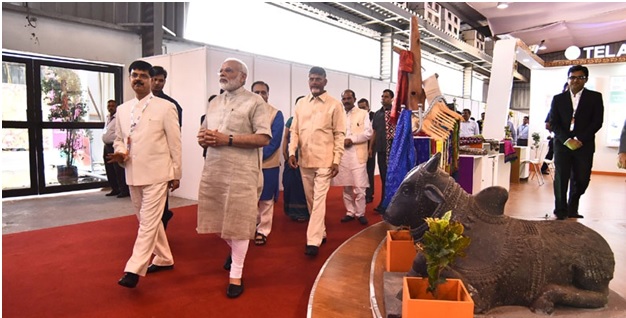- टेक्सटाइल इंडिया 2017 में आप सभी का स्वागत है। टेक्सटाइल सेक्टर में ये अब तक का देश का सबसे बड़ा कार्यक्रम है जिसमें दुनिया के 100 से ज्यादा देशों ने अपनी उपस्थिति दर्ज कराई है। मैं टेक्सटाइल मिनिस्ट्री, इस कार्यक्रम के आयोजकों, इसमें हिस्सा लेने आए उद्यमियों, कारीगरों को शुभकामनाएं देता हूं, बधाई देता हूं।
- टेक्सटाइल एक ऐसा क्षेत्र है जो एग्रीकल्चर और इंटस्ट्री के बीच एक अद्भुत bridge की तरह काम करता है। कपास की खेती हो, सिल्क का उत्पादन हो, इनका end product बहुत कुछ टेक्सटाइल सेक्टर पर निर्भर करता है। किसानों की मेहनत से उपजे raw material को बाजार मुहैया कराने का काम टेक्सटाइल सेक्टर करता है। यानि एक तरह से टेक्सटाइल agro और industry दोनों का ही part है।
- भारत के इतिहास में अगर किसी एक इंडस्ट्री का हमेशा महत्व रहा है, तो वो टेक्सटाइल इंडस्ट्री ही है।
- India is today described as a bright spot in the global economy. It has emerged as one of the most attractive global investment destinations. This has been made possible by a series of sustained policy initiatives.
- More than seven thousand reforms have been implemented to improve the ease of doing business. Processes have been simplified and made transparent. Government has repealed over twelve hundred outdated laws. These are just a few examples.
- Based on the “Make-in-India” initiative, the organized textile industry is being infused with the mantras of ‘skill, scale, speed’ and ‘zero-defect, zero-effect’ for scaling up employment, production and exports.
- There is also a high global demand for textiles and apparel manufactured in our country. India is the world’s second largest exporter of textiles, commanding a global share of around five percent. Indian textiles, including traditional handloom and handicraft products, are exported to more than a hundred countries.
- Sometimes, Indian tourists buy garments abroad, only to realize later, that they have been made in India.
- The textile sector offers significant employment opportunities. It is today, our second largest employer after agriculture. Over forty-five million people are employed directly in the sector, and over sixty million people are employed in allied activities.
- सरकार ने तय किया है कि Apparel और Made-up सेक्टर में जो भी कंपनी या कारोबारी नए श्रमिकों को रोजगार देते हैं उन्हें आर्थिक मदद दी जाएगी।
- इनकम टैक्स एक्ट के तहत भी इस सेक्टर की कंपनियों को छूट दी गई है। ऐसी मैन्यूफैक्चरिंग यूनिट्स जहां कम से कम 100 श्रमिक हैं, वो किसी नए श्रमिक को 150 दिन तक रोजगार देती हैं तो भी उन्हें टैक्स में राहत दी जा रही है।
- An integrated skill development scheme is also being implemented to address the critical gap of skilled manpower, through industry-oriented training programs.
- India is a country with diverse culture, fashion and traditions. This diversity is clearly reflected in the clothing present in different regions.
- Our integrated textile clusters are compliant to global standards of environment and health safety. Textile producing States also have pro-industry policies in place, to facilitate the required infrastructure for investments in textiles.
(The views expressed are the author's own and do not necessarily reflect the position of the organisation)

